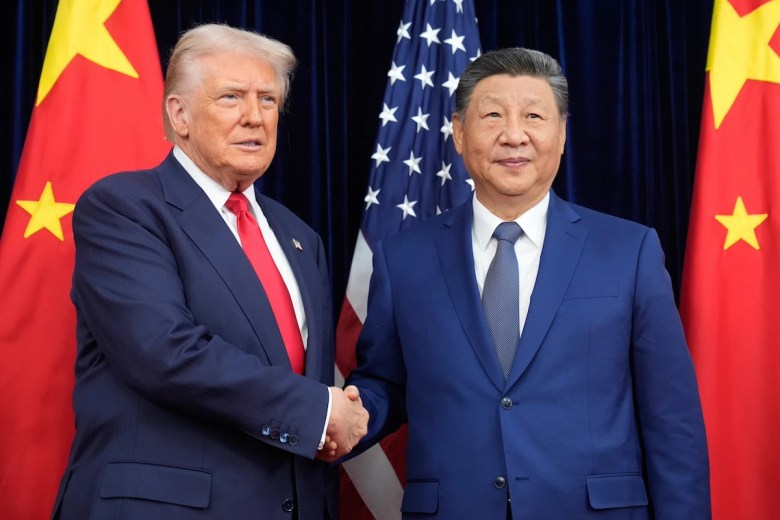Politics
Trump and Xi’s Trade Deal: Promises, Challenges, and Uncertainty

US President Donald Trump recently hailed a new trade agreement with China’s Xi Jinping, describing their meeting as “amazing” and suggesting that it would lead to significant changes in the trade dynamics between the two nations. The proposal involves reducing China’s tariffs to 47%, but analysts remain skeptical about the deal’s potential impact on the extensive $659 billion trade relationship.
Details surrounding the agreement remain vague, with specific targets and enforcement mechanisms yet to be finalized by trade officials from both countries. While both leaders aim to ease tensions, many experts doubt that the arrangement will fundamentally alter the underlying economic dynamics that define US-China trade.
Challenges ahead include numerous potential pitfalls that could reignite tensions. Factors such as currency fluctuations, economic slowdowns, and domestic political pressures could derail the agreement. “It’s good for the world’s top two largest economies to dial down tensions,” stated Ting Lu, an economist at Nomura Holdings. He added, “but we believe the superpower rivalry will likely escalate in the future,” indicating a complex landscape ahead for investors.
Economist Chang Shu at Bloomberg Economics expressed uncertainty about the deal’s lasting benefits for markets, noting that the new reality of US-China relations is characterized by frequent disruptions and temporary fixes. Jan Hatzius, an economist at Goldman Sachs, observed that recent policy shifts indicate a broader range of outcomes than previously anticipated. He suggested that both nations might scale back their most aggressive trade policies, leading to a possible extension of the tariff pause achieved in May.
While Trump views Xi as a rival business leader rather than an imperial figure, experts argue that this perspective may overlook the complexities of the relationship. “The allure of a single, sweeping deal is understandable,” noted Patricia Kim from the Brookings Institution, emphasizing that managing US-China relations requires continuous strategic effort rather than grand gestures.
The push for a comprehensive deal often encounters irreconcilable demands from both sides. For instance, US expectations include concessions on military aggression and non-market policies, which China is unlikely to accept. Kim pointed out that the narrative surrounding trade often ignores China’s own economic interventions, which complicate the notion of free trade.
Despite the current negotiations, Xi Jinping appears better prepared to navigate future challenges than Trump’s administration may realize. Following the initial trade war, China has shifted its focus to diversifying its trade partnerships, increasingly turning to Europe, Southeast Asia, and nations in the Global South. This pivot allows China to mitigate the impact of US tariffs while enhancing its competitiveness.
Chinese exporters have found ways to circumvent tariffs through transshipment and relocating production to countries with lower tariffs, according to Arthur Kroeber, head of research at Gavekal Dragonomics. He noted that these strategies have raised concerns for several Southeast Asian economies. Although exports to the US dropped 27% year-on-year in September 2023, global exports nonetheless reached a six-month high, climbing 8.3%.
China’s Ministry of Commerce has expressed dissatisfaction with US trade practices, accusing Washington of overreaching on national security issues and implementing discriminatory policies. The ministry stated, “the US actions have severely harmed China’s interests and undermined the atmosphere of bilateral economic and trade talks.”
Trump’s approach to trade reflects economic strategies from the mid-1980s, characterized by a focus on bilateral agreements and tariffs. This mindset ignores the evolving dynamics of global trade, where countries are restructuring supply chains around groups with shared values and security concerns. Gilles Moec, chief economist at AXA Investment, explained that this fragmentation is reshaping the global economy, emphasizing that new alliances are taking precedence over traditional globalization.
The implications of Trump’s trade policies extend beyond immediate negotiations. By reducing US development aid, for instance, Trump has inadvertently provided opportunities for China’s Belt and Road Initiative to expand its influence, especially in the Global South. Longtime Republican strategist Stuart Stevens criticized the administration’s lack of understanding regarding global dynamics, warning that current policies could diminish US power in favor of China and Russia.
As the landscape of US-China trade negotiations continues to evolve, the potential for significant disruption remains. Investors and central banks in Asia are already expressing concerns over the US’s growing debt and inflation issues, raising questions about the long-term viability of Trump’s trade approach. The coming months will reveal whether the current truce between Trump and Xi can withstand external pressures and internal challenges, reshaping global markets once more.
-

 Lifestyle3 months ago
Lifestyle3 months agoHumanism Camp Engages 250 Youths in Summer Fest 2025
-

 Sports3 months ago
Sports3 months agoDe Minaur Triumphs at Washington Open After Thrilling Comeback
-

 Business4 months ago
Business4 months agoKenvue Dismisses CEO Thibaut Mongon as Strategic Review Advances
-

 Sports4 months ago
Sports4 months agoTupou and Daugunu Join First Nations Squad for Lions Clash
-

 Top Stories4 months ago
Top Stories4 months agoColombian Senator Miguel Uribe Shows Signs of Recovery After Attack
-

 World4 months ago
World4 months agoASEAN Gears Up for Historic Joint Meeting of Foreign and Economic Ministers
-

 Business3 months ago
Business3 months agoOil Prices Surge Following New EU Sanctions on Russia
-

 Health3 months ago
Health3 months agoNew Study Challenges Assumptions About Aging and Inflammation
-

 Entertainment3 months ago
Entertainment3 months agoDetaşe-Sabah Violin Ensemble Captivates at Gabala Music Festival
-

 Entertainment3 months ago
Entertainment3 months agoBaku Metro Extends Hours for Justin Timberlake Concert
-

 Business4 months ago
Business4 months agoU.S. House Approves Stablecoin Bill, Sends to Trump for Signature
-

 Top Stories4 months ago
Top Stories4 months agoRethinking Singapore’s F&B Regulations Amid Business Closures









